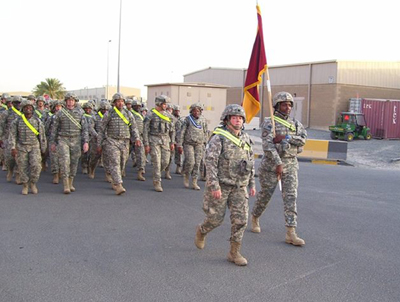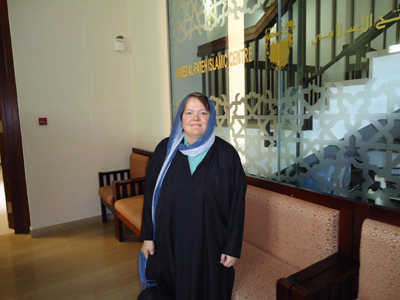September 2015
Teachers often compare the work over the semester to a grueling military campaign because of the trials and tribulations any given school year throws at them. By the end of the fall/spring academic “battles,” teachers feel exhausted but victorious knowing they’ve survived another tour of duty. This intellectual combat is not just a metaphor for Martha Kinney, associate professor of history at the Grant campus--who prefers to be called Murph. Although she started her career at SCCC in fall 2005, Murph was mobilized in the Army Reserves from fall 2010 through spring 2012, serving at Fort Dix and in Kuwait. Before she came to SCCC, Murph was an adjunct at Los Medanos College for four years and at Holy Names University for a year, but her experiences with teaching are not limited to the halls of academia. Most of Murph’s Army assignments involved a primary emphasis on training and while on active duty in 2010-11 she created and taught a graduate-level workshop in developing instructors to use active teaching techniques. Murph trained over 150 Army trainers in active learning. At SCCC Murph has a hard time picking a favorite class to teach, enjoying all the classes she’s been assigned, but one class that sticks out is HIS120: History of Religion. Although it fulfills a gen ed requirement, it is not a mandatory class like the western civilization sequence. Because it’s not required, a larger number of the students who take the course are interested at the outset. Murph notes that almost all students in the class realize they’ve had serious misconceptions about either their own religion or another world religion during the course of the semester, so there are lots of aha moments for these learners. Although her first goal of teaching is to get through the semester without a classroom mutiny (and to escape with a sense of humor), Murph’s pedagogical objectives are threefold:
While she’s considered herself an entertaining and engaging lecturer (one who often included active learning as part of the course), Murph has completely changed her methodology during the 2013-14 academic year to the flipped classroom. Students are expected to have gleaned the information they’re looking at outside of class (generally from the textbook and other assigned source material), and in class they work with that information to ask questions, to think through implications and to organize the information into a narrative. The results have been amazing, much better than Murph ever imagined. Because of SCCC’s status as a commuter school, most students aren’t here to make connections with the faculty but are here to earn their degree and move on with their lives. Yet, even with the fast-paced, displaced lives of SCCC’s student body, Murph has stayed in contact with a number of students over the years. Murph has gotten a lot of feedback on her flipped classroom model, almost all overwhelmingly positive. The best student response Murph’s received from a student is “this is the hardest class I’ve ever loved.”
As a veteran herself, Murph has a special affinity for the veterans at the college, and she was happy to teach a Freshman Seminar for Veterans in fall 2013. Her love of travel enhances the stories she can tell about European history and culture. For instance, Murph traveled twice to Europe in 2013, once to Malta and once to Prague. The neolithic religious structures in Malta and the 5000-year-old underground burial cavern played a prominent role in her History of Religion course. The Museum of Medieval Torture she visited in Prague allowed Murph to show some fairly gruesome photos in HIS101. Something certainly not torturous is Murph’s connection to the FA. Having adjuncted for a number of years in an environment in which the union was weak, she is grateful for the strength of the FA. According to Murph when the faculty knows that their working conditions will be protected, they can devote their time and energy to teaching rather than to grousing. This past academic year Murph has been on sabbatical, working on a critical thinking sourcebook for Western Civilization II. She hopes to weave in exercises specifically devoted to enhancing critical thinking skills incrementally in all her classes while using those exercises to also help students master course content. Murph also has been preparing to teach HIS118: Major World Cultures in fall 2015 and HIS201: Medieval History in spring 2016. In addition to these courses, she is developing a special topics course on Islamic history and society. Murph also wants to experiment more with her in-class exercises and activities and she’d like to be a resource for other instructors to test the waters of active learning and the flipped classroom. Whether it’s in the academic or literal trenches, Murph’s got your back! |


